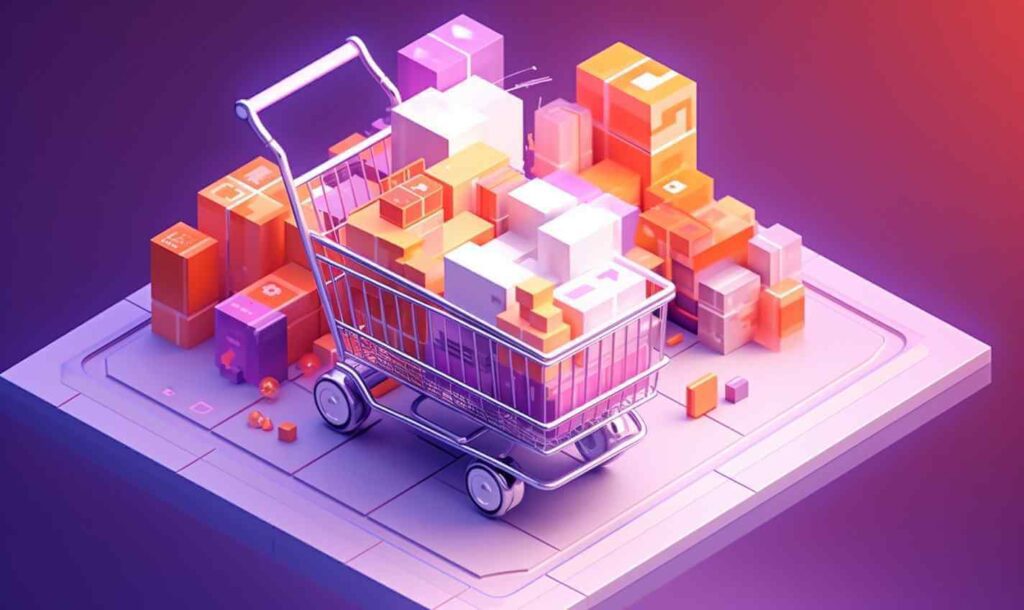- 1. Introduction
- 2. Choosing your niche
- 3. Setting up your online store
- 4. Finding and selecting suppliers
- 5. Inventory management
- 6. Pricing strategies
- 7. Marketing your store
- 8. Search engine optimization (SEO)
- 9. Customer service and support
- 10. Scaling your business
- 11. Legal and financial considerations
- 12. Dropshipping with the help of AI
- 13. How to automate dropshipping
- 14. Overcoming common dropshipping challenges
- 15. Success stories and case studies
- 16. Best Useful Tools, Websites, and Courses for Dropshipping
- 17. Conclusion
- 18. FAQs

1. Introduction
1.1. What is dropshipping?
Dropshipping is a modern and innovative business model that allows entrepreneurs to run e-commerce stores without holding inventory or dealing with the complexities of order fulfillment. In a dropshipping business, the store owner partners with a supplier or manufacturer, who then ships the products directly to the customers on the store owner’s behalf. This eliminates the need for the store owner to manage inventory, handle packaging, or deal with shipping logistics.
The dropshipping model has become increasingly popular in recent years due to the rise of e-commerce platforms like Shopify and WooCommerce, which make it easy for anyone to create an online store. With minimal startup costs, low overheads, and the ability to scale quickly, dropshipping has emerged as a viable option for aspiring entrepreneurs to launch their own businesses without the traditional barriers to entry.
1.2. Why choose dropshipping?
There are several reasons why dropshipping has become an attractive choice for e-commerce entrepreneurs:
- Low startup costs: Unlike traditional brick-and-mortar businesses, dropshipping doesn’t require a significant upfront investment. You don’t need to purchase inventory, rent a storage space, or invest in expensive equipment. All you need is a functional e-commerce website and a reliable supplier.
- Minimal overhead: With no inventory to manage or physical store to maintain, the ongoing costs of running a dropshipping business are relatively low. This allows entrepreneurs to focus on marketing and growing their businesses without being burdened by high overheads.
- Flexibility: Dropshipping provides a high degree of flexibility, as you can operate your business from virtually anywhere with an internet connection. This freedom allows entrepreneurs to work from home or even travel the world while running their businesses.
- Scalability: As your dropshipping business grows, you can easily expand your product range and customer base without the logistical challenges associated with managing inventory. The ability to scale quickly and efficiently is a significant advantage of the dropshipping model.
- Lower risk: Because you’re not investing in inventory upfront, there’s less financial risk involved in starting a dropshipping business. If a product doesn’t sell well, you can simply remove it from your store without having to deal with unsold inventory.
By choosing dropshipping as your business model, you can enjoy the benefits of running an e-commerce store without the traditional challenges and risks associated with managing inventory and fulfilling orders. This makes it an ideal choice for aspiring entrepreneurs looking to break into the world of e-commerce.
1.3. The rise of e-commerce
The rapid growth of the internet and advancements in technology have fueled the rise of e-commerce, transforming the way people shop and do business worldwide. E-commerce platforms such as Amazon, eBay, and Alibaba have revolutionized the retail landscape, making it easier than ever for consumers to find and purchase products online.
Several factors have contributed to the rise of e-commerce:
- Convenience: Online shopping offers consumers the ability to shop 24/7 from the comfort of their homes, without the need to visit physical stores. This convenience has made e-commerce an increasingly popular choice for customers seeking a seamless and hassle-free shopping experience.
- Global reach: E-commerce allows businesses to reach customers across the globe, breaking down geographical barriers and expanding their market potential.
- Personalization: E-commerce platforms have made it possible for businesses to offer personalized shopping experiences, tailoring product recommendations and marketing efforts to individual customer preferences.
- Mobile technology: The widespread adoption of smartphones and tablets has further accelerated the growth of e-commerce, with more consumers than ever before making purchases through mobile devices.
- Social media: The integration of social media and e-commerce has created new opportunities for businesses to connect with customers, build brand awareness, and drive sales through targeted advertising and influencer partnerships.
The rise of e-commerce has created a fertile ground for the growth of the dropshipping business model, as entrepreneurs capitalize on the increasing demand for online shopping and the ease of setting up an online store.
1.4. The benefits of dropshipping
The dropshipping model offers several unique benefits that make it an attractive choice for e-commerce entrepreneurs:
- No inventory management: Since suppliers handle inventory and order fulfillment, dropshippers can focus on marketing, customer service, and growing their business without the complexities of managing stock.
- Low barriers to entry: With minimal startup costs and no need for a physical storefront or inventory, dropshipping makes it accessible for aspiring entrepreneurs to launch their own e-commerce businesses.
- Wide product selection: Dropshippers can easily experiment with different products and niches, as they’re not limited by the need to purchase and store inventory. This allows for quick adaptation to market trends and customer preferences.
- Reduced risk: The lack of upfront inventory investment means that dropshippers face lower financial risk in the event that a product doesn’t sell well. This flexibility enables them to pivot and adapt their product offerings more easily than traditional retailers.
- Streamlined operations: The dropshipping model simplifies business operations, allowing entrepreneurs to run their businesses with minimal overhead and fewer logistical challenges.
Overall, dropshipping provides a unique and appealing alternative to traditional e-commerce, enabling entrepreneurs to capitalize on the growing popularity of online shopping while enjoying the benefits of a simplified and scalable business model.

2. Choosing your niche
2.1. How to identify a profitable niche
Selecting the right niche is a crucial first step in building a successful dropshipping business. A niche is a specific market segment or product category that you will focus on in your online store. To identify a profitable niche, consider the following factors:
- Demand: Research the market to determine if there is sufficient demand for the products in your chosen niche. Tools like Google Trends, Keyword Planner, and Amazon Best Sellers can help you gauge consumer interest in your target niche.
- Profit margin: Look for niches with products that have a high-profit margin, which will help you generate significant income even if you sell fewer items. You can achieve this by offering high-quality, unique, or premium products that justify a higher price point.
- Target audience: Identify a specific target audience for your niche, as this will help you tailor your marketing efforts and product selection to meet the needs and preferences of your customers. Consider demographics, psychographics, and purchasing behavior when defining your target audience.
- Passion and expertise: Choose a niche that you are passionate about and knowledgeable in, as this will help you stay motivated, create engaging content, and build trust with your customers.
- Low market saturation: While some competition is healthy, it’s essential to avoid niches that are oversaturated. Look for a niche with a moderate level of competition, indicating that there is room for growth and differentiation.
2.2. Analyzing the competition
Competitor analysis is an essential aspect of choosing a profitable niche, as it allows you to understand the market landscape and identify gaps and opportunities for growth. To analyze your competition, follow these steps:
- Identify your competitors: Make a list of the top online stores and brands operating in your chosen niche. You can use tools like Ahrefs, SEMrush, or SimilarWeb to find relevant competitors.
- Evaluate their websites: Visit each competitor’s website and assess their product offerings, pricing, website design, and overall customer experience. Look for strengths and weaknesses that you can capitalize on in your own store.
- Analyze their marketing strategies: Examine the marketing channels and tactics used by your competitors, including social media, content marketing, email marketing, and paid advertising. Determine which strategies are most effective and consider how you can improve upon or differentiate your own marketing efforts.
- Assess their customer engagement: Check customer reviews, social media interactions, and other forms of engagement to understand your competitors’ reputation and customer satisfaction levels. This information can help you identify areas where you can offer a superior customer experience.
- Look for gaps and opportunities: Based on your competitor analysis, identify any gaps in the market or unmet customer needs that you can address in your own dropshipping business. This could include unique products, better pricing, improved customer service, or more targeted marketing efforts.
By thoroughly analyzing your competition and selecting a profitable niche, you’ll be well-positioned to create a successful dropshipping business that stands out in the market.
2.3. The importance of passion and expertise
Passion and expertise play a significant role in the success of your dropshipping business. Here’s why they matter:
- Motivation: Running a business requires dedication and hard work, especially during the initial stages. Being passionate about your niche helps maintain your motivation and enthusiasm, even during challenging times.
- Engaging content: When you’re genuinely interested in your niche, you’re more likely to create engaging content that resonates with your target audience. This includes blog posts, social media updates, and email newsletters, all of which contribute to building your brand and driving traffic to your store.
- Trust and credibility: Your expertise in the niche establishes you as a trusted and credible source of information, which helps build customer trust and loyalty. Customers are more likely to buy from someone who is knowledgeable about the products they sell and can provide valuable insights and advice.
- Better decision-making: Your passion and expertise enable you to make more informed decisions about product selection, marketing strategies, and other aspects of your business. This knowledge can help you identify trends, anticipate customer needs, and adapt your business to stay ahead of the competition.
- Networking opportunities: When you’re passionate about your niche, you’re more likely to engage with industry peers, influencers, and potential partners. This can lead to valuable networking opportunities, collaborations, and mutually beneficial relationships that can help grow your business.
2.4. Validating your niche idea
Before fully committing to your chosen niche, it’s crucial to validate your idea to ensure that it’s viable and profitable. Here are some steps to validate your niche:
- Conduct market research: Gather data on your target audience, their preferences, and purchasing habits. This will help you determine if there’s sufficient demand for your products.
- Analyze the competition: As mentioned earlier, analyze your competitors to identify gaps and opportunities in the market. Ensure that there’s room for your business to differentiate itself and stand out in the market.
- Test your product offerings: Before launching your full online store, consider setting up a small test store or using a platform like eBay or Amazon to gauge customer interest in your products. This will help you understand whether your products resonate with your target audience and if there’s potential for success.
- Seek feedback: Share your niche idea with friends, family, or industry peers to get their honest feedback and insights. Their input can help you refine your idea and identify any potential issues or concerns.
- Assess profitability: Evaluate the potential profit margins for your niche, considering factors such as product costs, shipping fees, and marketing expenses. Ensure that your niche can generate sufficient revenue to support and grow your business.
By validating your niche idea, you’ll gain confidence in your business concept and reduce the risk of investing time and resources into a venture that may not be successful.

3. Setting up your online store
3.1. Selecting an e-commerce platform
Choosing the right e-commerce platform is essential for the success of your dropshipping business, as it will impact the overall functionality and user experience of your online store. Here are some popular e-commerce platforms to consider for your dropshipping store:
- Shopify: A user-friendly and feature-rich platform, Shopify is specifically designed for e-commerce businesses and offers a range of apps and integrations to streamline your dropshipping operations. Shopify’s robust infrastructure, extensive support resources, and seamless integration with popular dropshipping apps like Oberlo make it an excellent choice for beginners and experts alike.
- WooCommerce: WooCommerce is a popular, open-source e-commerce plugin for WordPress websites. It offers a high level of customization and control, making it suitable for those who are comfortable with WordPress and want to build a more unique online store. However, it requires more technical knowledge than Shopify and may have a steeper learning curve for beginners.
- BigCommerce: BigCommerce is another powerful e-commerce platform that offers a comprehensive set of features and tools for managing your online store. It supports multiple sales channels, including Amazon, eBay, and social media platforms, and integrates with popular dropshipping apps like AliExpress and Printful.
- Magento: Magento is a feature-rich, open-source e-commerce platform geared towards larger businesses and developers with advanced technical skills. It offers a high level of customization and scalability but requires more development expertise and maintenance compared to other platforms.
When selecting an e-commerce platform, consider factors such as ease of use, available features, scalability, integration with dropshipping suppliers, and pricing.
3.2. Designing your website
A well-designed website is crucial for creating a positive first impression and converting visitors into customers. Follow these guidelines when designing your dropshipping website:
- Choose a professional theme: Select a clean, modern, and responsive theme that aligns with your brand and niche. Many e-commerce platforms offer a range of customizable themes to choose from, making it easy to find one that suits your needs.
- Prioritize user experience: Ensure that your website is easy to navigate, with clear menus and a logical layout. Optimize your site for mobile devices, as an increasing number of customers shop on smartphones and tablets.
- High-quality product images: Use high-resolution, professional-looking images to showcase your products. This is crucial for building trust with your customers, as they rely on images to assess the quality and features of your products.
- Compelling product descriptions: Write detailed, engaging, and informative product descriptions that highlight the key features and benefits of your products. Use persuasive language and focus on addressing your customers’ needs and pain points.
- Seamless checkout process: Streamline the checkout process to reduce cart abandonment and increase conversions. Offer multiple payment options, enable guest checkout, and provide clear shipping and return policies.
By selecting the right e-commerce platform and designing an attractive, user-friendly website, you’ll be well on your way to building a successful dropshipping business.
3.3. Creating product listings
Effective product listings play a vital role in converting visitors into customers. To create compelling product listings for your dropshipping store, follow these guidelines:
- Clear and concise titles: Craft product titles that accurately describe the item and include relevant keywords to optimize searchability. Keep your titles concise and easy to understand.
- High-quality images: As mentioned earlier, use high-resolution, professional-looking images to showcase your products. Include multiple images from different angles to provide a comprehensive visual representation of the item.
- Informative descriptions: Write detailed and engaging product descriptions that clearly highlight the features and benefits of your products. Address common questions and concerns, and use persuasive language to entice customers to make a purchase.
- Competitive pricing: Research the market to determine competitive pricing for your products. Factor in your costs, desired profit margin, and competitors’ prices to set an attractive yet profitable price point.
- Product variations: If applicable, include product variations such as size, color, or material options. Make sure to provide clear information and images for each variation to help customers make an informed decision.
- Stock availability: Display accurate stock information for each product, as this can influence customers’ purchase decisions. Many e-commerce platforms and dropshipping apps can automatically sync stock levels with your suppliers.
- Shipping information: Provide clear and transparent shipping information, including estimated delivery times and shipping costs. This will help set customer expectations and reduce potential confusion or disappointment.
3.4. Developing website policies
Creating clear and comprehensive website policies is essential for building trust with your customers and protecting your business from potential legal issues. Consider including the following policies on your website:
- Privacy policy: Outline how you collect, use, and protect customers’ personal information. This policy is legally required in many jurisdictions and helps establish trust with your customers.
- Terms of service: Specify the rules and guidelines that customers must agree to when using your website. This policy should cover aspects like user accounts, order processing, and intellectual property rights.
- Shipping policy: Provide detailed information on your shipping methods, delivery times, shipping costs, and any applicable restrictions. This policy helps set customer expectations and avoid potential disputes.
- Return and refund policy: Clearly explain the process for returning items, including the acceptable reasons for returns, required documentation, and the timeframe for processing refunds or exchanges. This policy can help reduce the likelihood of disputes and ensure a smooth return process for your customers.
- Payment policy: Outline the accepted payment methods, any applicable fees or taxes, and the process for handling disputes or chargebacks.
By creating well-crafted product listings and developing clear website policies, you can create a positive customer experience and increase the likelihood of repeat business in your dropshipping store.

4. Finding and selecting suppliers
4.1. Identifying reliable suppliers
Working with reliable suppliers is crucial for the success of your dropshipping business, as it directly affects your customers’ satisfaction and your store’s reputation. To identify reliable suppliers, follow these steps:
- Research potential suppliers: Start by creating a list of potential suppliers that cater to your niche. You can find suppliers using platforms like AliExpress, SaleHoo, or Doba, or by searching for specific products and their manufacturers.
- Check supplier reputation: Look for suppliers with positive reviews and ratings, as this indicates a history of providing good service and products. You can also research suppliers through online forums, social media, and other industry resources to gather more information about their reputation.
- Assess product quality: Order samples from potential suppliers to evaluate the quality of their products. This will help you ensure that you’re offering high-quality items that meet your customers’ expectations.
- Evaluate communication: Test the supplier’s responsiveness and professionalism by contacting them with questions or concerns. A reliable supplier should provide prompt and clear communication, which is essential for maintaining a strong working relationship.
- Verify business credentials: Check the supplier’s business credentials, such as licenses, certifications, and trade memberships, to ensure that they’re a legitimate and trustworthy operation.
4.2. Evaluating supplier performance
Once you’ve identified potential suppliers, it’s essential to continually evaluate their performance to ensure they continue to meet your expectations. Consider the following criteria when evaluating supplier performance:
- Order fulfillment: Track the supplier’s ability to fulfill orders accurately and on time. Consistently late or incorrect shipments can negatively impact your customer satisfaction and store reputation.
- Product quality: Monitor the quality of the products you receive from the supplier. If you notice a decline in quality or an increase in defective items, this could indicate issues with the supplier’s manufacturing processes.
- Communication: Assess the supplier’s responsiveness and professionalism in handling inquiries, concerns, and issues. Effective communication is crucial for maintaining a successful partnership.
- Flexibility: Evaluate the supplier’s ability to adapt to changes in your business needs, such as increased order volumes, new product requests, or changes in shipping requirements.
- Pricing: Keep an eye on the supplier’s pricing structure to ensure it remains competitive and allows you to maintain a healthy profit margin.
By carefully selecting and continually evaluating your suppliers, you can build a strong foundation for your dropshipping business and ensure a consistent, high-quality customer experience.
4.3. Building strong relationships with suppliers
Cultivating strong relationships with your suppliers is crucial for the long-term success of your dropshipping business. Here are some tips for building positive and mutually beneficial relationships with your suppliers:
- Maintain open communication: Regularly communicate with your suppliers to keep them informed about your business needs and any changes in your requirements. Open communication helps build trust and ensures both parties are on the same page.
- Be professional: Treat your suppliers with respect and professionalism, just as you would with your customers. This helps establish a positive working relationship and encourages your suppliers to prioritize your business.
- Pay on time: Promptly pay your suppliers according to the agreed-upon terms. This demonstrates your commitment to the partnership and helps build trust.
- Provide feedback: Share feedback on product quality, packaging, and delivery with your suppliers. Constructive feedback can help suppliers improve their services and ensure they continue to meet your expectations.
- Be understanding: Recognize that suppliers, like any other business, may face challenges and difficulties. Be understanding and patient when issues arise, and work collaboratively to find solutions.
4.4. Negotiating terms and agreements
Negotiating favorable terms and agreements with your suppliers can help improve your profit margins and ensure a more efficient supply chain. Consider the following when negotiating with suppliers:
- Pricing: Aim to negotiate the best possible price for your products without compromising on quality. Leverage your research on market prices, competitor pricing, and order volumes to negotiate a fair price.
- Payment terms: Discuss payment terms with your suppliers to find a mutually agreeable arrangement. This could include negotiating extended payment deadlines, discounts for early payments, or other incentives that can benefit both parties.
- Shipping costs: Negotiate shipping costs and delivery times to find the most cost-effective and efficient options for your business. This can help reduce your overheads and improve customer satisfaction.
- Exclusive agreements: If you have a particularly strong relationship with a supplier, consider negotiating an exclusive agreement that gives you sole rights to sell their products within your niche or region. This can help differentiate your store from competitors and potentially secure better pricing or terms.
- Minimum order quantities (MOQs): Some suppliers may require minimum order quantities for certain products. If you’re just starting out or have limited storage space, consider negotiating lower MOQs or exploring alternative suppliers that offer more flexibility.
By building strong relationships with suppliers and negotiating favorable terms and agreements, you can improve the efficiency and profitability of your dropshipping business.

5. Inventory management
5.1. Understanding stock levels
In a dropshipping business, managing inventory is primarily the responsibility of your suppliers. However, it’s essential to stay informed about your suppliers’ stock levels to ensure a smooth customer experience. Here’s how to effectively monitor and understand stock levels:
- Supplier inventory updates: Regularly check your suppliers’ inventory updates, which may be available through their website, a shared spreadsheet, or API integration with your e-commerce platform.
- Inventory synchronization: Use tools or apps that automatically sync your suppliers’ stock levels with your online store. Many e-commerce platforms offer integrations with popular dropshipping apps, making it easier to manage and update your store’s inventory.
- Product availability alerts: Set up notifications to alert you when a product’s stock level drops below a certain threshold. This can help you proactively manage out-of-stock situations and prevent customer disappointment.
- Alternative suppliers: Identify backup suppliers for popular products to minimize the risk of stockouts. This can help ensure product availability and maintain customer satisfaction even if your primary supplier runs out of stock.
5.2. Managing backorders
Backorders occur when a customer orders a product that is temporarily out of stock. Managing backorders effectively is crucial for maintaining customer satisfaction and ensuring a positive shopping experience. Here are some tips for handling backorders in your dropshipping business:
- Transparent communication: Clearly communicate the backorder status on your website, including the expected restocking date and any potential delays in delivery. Transparency helps set realistic customer expectations and reduces the likelihood of complaints or cancellations.
- Offer alternatives: Suggest similar or substitute products that are in stock as an alternative for customers who don’t want to wait for a back-ordered item. This can help retain customers and generate additional sales.
- Prioritize restocking: Communicate with your supplier to prioritize restocking of the back-ordered item, if possible. This can help minimize delays and ensure a faster turnaround time for your customers.
- Flexible cancellation policies: Offer customers the option to cancel their back-ordered items without penalties if they prefer not to wait. This demonstrates understanding and helps maintain a positive customer relationship.
- Monitor supplier performance: Track the frequency of backorders and assess whether a particular supplier is consistently struggling with stock availability. If necessary, consider switching to a more reliable supplier to minimize backorder issues.
Effective inventory management, including understanding stock levels and managing backorders, is essential for ensuring a seamless customer experience in your dropshipping business.
5.3. Supplier communication and order tracking
Maintaining clear communication with suppliers and keeping track of orders is crucial for managing inventory and ensuring the timely delivery of products to your customers. Here are some tips for effective supplier communication and order tracking:
- Establish a communication protocol: Set up a standardized communication process with your suppliers, which may include email, phone calls, or messaging apps. This helps ensure that both parties are informed about order status, inventory updates, and any potential issues.
- Provide clear order information: When submitting orders to your suppliers, provide accurate and detailed information, including product SKUs, quantities, shipping addresses, and any special instructions. This helps prevent errors and ensures a smooth fulfillment process.
- Request order confirmations: Request that your suppliers provide a confirmation for each order, including a tracking number and expected delivery date. This information can be shared with your customers, allowing them to track their packages and stay informed about delivery status.
- Regularly monitor order status: Track the progress of your orders by regularly checking the tracking information provided by your suppliers. This helps you identify potential delays or issues early on, allowing you to proactively address them and maintain customer satisfaction.
5.4. Utilizing inventory management software
Inventory management software can be an invaluable tool for efficiently managing your dropshipping business’s inventory and order fulfillment. Here are some benefits of using inventory management software:
- Real-time inventory updates: Inventory management software can automatically sync your suppliers’ stock levels with your online store, providing real-time updates on product availability.
- Order automation: Some inventory management software allows you to automate the order submission process, streamlining the fulfillment process and reducing the likelihood of errors.
- Centralized order tracking: Inventory management software can provide a centralized platform for tracking orders from multiple suppliers, making it easier to monitor order status and manage customer inquiries.
- Reporting and analytics: Many inventory management software solutions offer reporting and analytics features, which can help you analyze sales trends, identify popular products, and optimize your inventory strategy.
- Integration with e-commerce platforms: Many inventory management software solutions can integrate with popular e-commerce platforms, making it easy to manage your online store’s inventory and order fulfillment.
By effectively communicating with suppliers, tracking orders, and utilizing inventory management software, you can streamline your dropshipping business’s operations and ensure a positive customer experience.

6. Pricing strategies
Developing effective pricing strategies is essential for maximizing your dropshipping business’s profitability and attracting customers. Here are two popular pricing strategies to consider:
6.1. Competitive pricing
Competitive pricing involves setting your product prices based on the prices of similar products in the market. This strategy helps you stay competitive and attract price-conscious customers. To implement competitive pricing, follow these steps:
- Research competitor prices: Regularly monitor the prices of similar products offered by your competitors. This can help you understand the market value of the items you’re selling and identify any trends or changes in pricing.
- Calculate your costs: Take into account your costs, such as supplier prices, shipping fees, taxes, and platform fees, to ensure that you’re still making a profit at the competitive price point.
- Consider value-added services: If you offer additional benefits, such as superior customer service, faster shipping, or exclusive product bundles, factor these into your pricing strategy. These value-added services can help justify a slightly higher price compared to your competitors.
- Regularly review and adjust prices: Continuously monitor the market and adjust your prices as needed to remain competitive and maximize profits.
6.2. Psychological pricing
Psychological pricing involves setting prices in a way that appeals to customers’ perceptions of value and encourages them to make a purchase. Some common psychological pricing techniques include:
- Charm pricing: Charm pricing involves setting prices slightly below a round number, such as $9.99 instead of $10. This strategy can create the perception of a better deal and encourage customers to buy.
- Price anchoring: Price anchoring involves displaying a higher “original” price next to a discounted price, emphasizing the perceived value and savings. This tactic can create a sense of urgency and encourage customers to make a purchase.
- Bundle pricing: Bundle pricing involves offering multiple products together at a lower price than if they were purchased separately. This can create the perception of added value and increase the average order value.
- Decoy pricing: Decoy pricing involves introducing a higher-priced option to make other options appear more attractive. This can encourage customers to choose a more profitable item or a higher-priced package.
Experimenting with different pricing strategies can help you find the optimal approach for your dropshipping business, ensuring that you remain competitive, attract customers, and maximize profitability.
6.3. Dynamic pricing
Dynamic pricing is a strategy that involves adjusting product prices based on factors such as market demand, competitor pricing, and seasonality. This approach allows you to remain competitive and maximize profitability by responding to market fluctuations in real-time. Here’s how to implement dynamic pricing:
- Monitor market trends: Regularly analyze market data and trends to identify changes in demand and pricing. This will help you stay informed and make informed pricing decisions.
- Track competitor pricing: Keep a close eye on competitor prices and adjust your own prices accordingly to stay competitive. This may involve using price comparison tools or manually monitoring competitor websites.
- Utilize pricing software: Invest in dynamic pricing software that automatically updates your product prices based on real-time market data. Many e-commerce platforms offer integrations with dynamic pricing tools, simplifying the process of updating your prices.
- Implement price limits: Set minimum and maximum price limits for your products to ensure that you maintain a healthy profit margin while remaining competitive.
- Test and refine: Regularly evaluate the effectiveness of your dynamic pricing strategy and make adjustments as needed. This may involve experimenting with different pricing models or adjusting your price limits.
6.4. Price anchoring
Price anchoring is a psychological pricing technique that helps create the perception of value by displaying a higher “original” price next to a discounted price. This strategy emphasizes the savings and makes the discounted price more appealing to customers. Here’s how to use price anchoring effectively:
- Determine original prices: Set an original price that accurately reflects the market value of the product, taking into account factors such as product quality, brand reputation, and competitor pricing.
- Offer meaningful discounts: Apply a discount to the original price that represents genuine savings for the customer. This could be a percentage discount, a fixed dollar amount, or a limited-time promotional offer.
- Highlight the savings: Clearly display the original price alongside the discounted price, using visual elements such as strikethroughs, contrasting colors, or bold text to emphasize the savings.
- Create urgency: Use time-sensitive promotions or limited stock availability to create a sense of urgency, encouraging customers to make a purchase before the offer expires or the product sells out.
- Test and optimize: Regularly review the effectiveness of your price anchoring strategy and make adjustments as needed. This may involve experimenting with different discount levels, promotional offers, or visual elements.
By implementing dynamic pricing and price anchoring strategies, you can optimize your dropshipping business’s pricing to remain competitive, attract customers, and maximize profitability.

7. Marketing your store
To attract customers and drive sales, it’s essential to implement effective marketing strategies for your dropshipping business. Here are two popular marketing techniques to consider:
7.1. Social media marketing
Social media platforms offer a powerful way to engage with potential customers, increase brand awareness, and drive traffic to your online store. Here’s how to get started with social media marketing:
- Choose relevant platforms: Identify the social media platforms that are most popular with your target audience. Common platforms for e-commerce businesses include Facebook, Instagram, Pinterest, and Twitter.
- Create engaging content: Develop a mix of promotional, educational, and entertaining content that appeals to your audience. This could include product showcases, customer testimonials, behind-the-scenes looks, or industry news.
- Interact with your audience: Respond to comments and messages, engage with other users’ content, and participate in relevant online communities to foster relationships with potential customers.
- Use hashtags and keywords: Incorporate relevant hashtags and keywords in your posts to increase visibility and reach a broader audience.
- Run targeted ads: Utilize paid advertising options on social media platforms to reach a larger audience and attract potential customers.
7.2. Content marketing
Content marketing involves creating and sharing valuable content to attract, engage, and convert potential customers. This can help establish your brand as an authority in your niche and drive traffic to your online store. Here’s how to get started with content marketing:
- Identify your target audience: Understand the needs, preferences, and pain points of your target customers to create content that resonates with them.
- Develop a content plan: Create a content calendar that outlines the topics, formats, and publishing schedule for your content. This could include blog posts, videos, podcasts, or infographics.
- Focus on quality: Produce high-quality content that provides value, educates, or entertains your audience. This will help build trust and credibility with potential customers.
- Optimize for SEO: Incorporate relevant keywords and optimize your content for search engines to improve its visibility and attract organic traffic.
- Promote your content: Share your content across social media platforms, email newsletters, and other marketing channels to increase its reach and attract potential customers.
By implementing social media marketing and content marketing strategies, you can effectively promote your dropshipping store, engage with potential customers, and drive sales.
7.3. Email marketing
Email marketing is an effective way to communicate with potential and existing customers, promote products, and drive sales for your dropshipping business. Here’s how to get started with email marketing:
- Build your email list: Encourage visitors to subscribe to your email list by offering incentives such as discounts, exclusive content, or early access to new products. Make the sign-up process simple and visible on your website.
- Segment your list: Categorize your subscribers based on factors such as purchase history, demographics, or interests. This will help you tailor your email content to better resonate with different segments of your audience.
- Craft engaging content: Develop a mix of promotional, educational, and personalized content for your emails. This could include product announcements, limited-time offers, helpful tips, or personalized product recommendations.
- Use eye-catching subject lines: Write attention-grabbing subject lines to encourage recipients to open your emails. Keep them short, relevant, and enticing.
- Optimize for mobile devices: Ensure your email design and content is optimized for viewing on mobile devices, as many users check their emails on smartphones or tablets.
- Analyze and optimize: Monitor your email marketing performance through metrics such as open rates, click-through rates, and conversions. Use these insights to improve your email content and strategy.
7.4. Influencer marketing
Influencer marketing involves partnering with influential individuals in your niche to promote your products and reach a larger audience. Here’s how to get started with influencer marketing:
- Identify potential influencers: Look for individuals with strong following and high engagement rates on social media platforms relevant to your target audience.
- Evaluate influencer fit: Assess whether the influencer’s content, style, and audience align with your brand and target customers.
- Reach out to influencers: Send personalized messages to potential influencers, explaining your interest in collaborating and outlining the benefits of partnering with your brand.
- Negotiate terms: Discuss the terms of your partnership, including compensation, expectations, and any guidelines or requirements related to the promotion of your products.
- Provide creative freedom: Allow influencers to create content in their own style, as this will resonate better with their audience and maintain authenticity.
- Monitor and measure results: Track the performance of your influencer marketing campaigns by monitoring metrics such as engagement, conversions, and return on investment (ROI).
By incorporating email marketing and influencer marketing strategies, you can effectively promote your dropshipping store, engage with potential customers, and boost sales.
7.5. Paid advertising
Paid advertising can help you reach a larger audience, attract potential customers, and drive sales for your dropshipping business. Here are some commonly paid advertising channels to consider:
- Google Ads: Run search and display ads on Google to reach potential customers when they search for relevant keywords or browse websites related to your niche.
- Social media ads: Utilize paid advertising options on social media platforms such as Facebook, Instagram, and Pinterest to target users based on demographics, interests, and behavior.
- Affiliate marketing: Partner with affiliates to promote your products in exchange for a commission on sales generated through their referrals.
- Sponsored content: Collaborate with bloggers or content creators in your niche to create sponsored content that promotes your products and drives traffic to your online store.
- Retargeting campaigns: Use retargeting ads to re-engage users who have previously visited your website or interacted with your brand, increasing the likelihood of converting them into customers.
Monitor the performance of your paid advertising campaigns and optimize them to maximize your return on investment (ROI).

8. Search engine optimization (SEO)
Effective search engine optimization (SEO) can help improve your website’s visibility on search engines, attract organic traffic, and increase sales for your dropshipping business.
8.1. On-page SEO
On-page SEO involves optimizing individual web pages to rank higher on search engine results pages (SERPs) and attract more organic traffic. Here’s how to get started with on-page SEO:
- Conduct keyword research: Identify relevant keywords and phrases that potential customers are likely to use when searching for products or information related to your niche.
- Optimize your content: Incorporate your target keywords naturally throughout your website content, including headings, body text, image alt tags, and meta descriptions.
- Create high-quality content: Produce valuable, informative, and engaging content that addresses the needs and interests of your target audience. High-quality content is more likely to be shared and linked to, increasing its visibility and authority.
- Use descriptive URLs: Create simple, descriptive, and keyword-rich URLs for your web pages, making it easier for search engines to understand and index your content.
- Optimize your website’s structure: Organize your website in a clear, logical, and user-friendly manner. This includes using a hierarchical structure, incorporating internal links, and creating a comprehensive sitemap.
- Improve page loading speed: Optimize your website’s performance by compressing images, minifying CSS and JavaScript files, and utilizing caching techniques to reduce page load times.
- Ensure mobile-friendliness: Ensure your website is optimized for viewing on mobile devices, as a significant portion of online traffic comes from smartphones and tablets.
By implementing on-page SEO strategies, you can improve your dropshipping store’s visibility on search engines, attract organic traffic, and drive sales.
8.2. Off-page SEO
Off-page SEO involves optimizing factors outside your website that influence your search engine rankings. This primarily focuses on building the authority and credibility of your website through backlinks. Here’s how to get started with off-page SEO:
- Create shareable content: Produce high-quality content that is valuable, engaging, and share-worthy. This increases the likelihood of other websites linking to your content, which can improve your search engine rankings.
- Build relationships: Engage with influencers, bloggers, and other relevant websites in your niche to establish relationships and create opportunities for collaboration or guest posting.
- Guest blogging: Contribute high-quality guest posts to reputable websites in your niche to earn backlinks and drive traffic to your site.
- Social media marketing: Promote your content on social media platforms to increase its visibility and encourage others to share and link to it.
- Participate in online communities: Engage in relevant forums, Q&A sites, and online communities related to your niche. Share your expertise and include links to your website when appropriate.
- Analyze your backlink profile: Regularly monitor your backlink profile to identify any spammy or low-quality links that may be harming your website’s authority. Use tools like Google Search Console or third-party SEO tools to track your backlinks.
8.3. Technical SEO
Technical SEO involves optimizing the backend aspects of your website to improve its search engine visibility and user experience. Here’s how to get started with technical SEO:
- Optimize site speed: Improve your website’s loading speed by compressing images, minifying CSS and JavaScript files, and utilizing caching techniques.
- Ensure mobile-friendliness: Make sure your website is responsive and optimized for viewing on mobile devices, as a significant portion of online traffic comes from smartphones and tablets.
- Create an XML sitemap: Generate an XML sitemap that lists all of your website’s pages, making it easier for search engines to crawl and index your content.
- Use structured data: Implement schema markup to provide search engines with additional information about your website’s content, improving its visibility in search results.
- Fix broken links: Regularly check for broken links on your website and fix or remove them to improve user experience and prevent potential issues with search engine crawling.
- Implement HTTPS: Secure your website with HTTPS to protect user data and improve your website’s credibility in the eyes of search engines.
- Optimize website crawlability: Ensure search engines can easily crawl and index your website by organizing its structure, incorporating internal links, and addressing any crawl errors or issues.
By focusing on off-page SEO and technical SEO, you can further improve your dropshipping store’s search engine visibility, attract more organic traffic, and boost sales.
8.4. Keyword research
Keyword research is an essential aspect of SEO, helping you identify the most relevant and high-traffic keywords to target in your website content. Here’s how to conduct effective keyword research:
- Define your goals: Determine the primary objectives of your keyword research, such as driving traffic, increasing conversions, or improving brand awareness.
- Identify seed keywords: Brainstorm a list of initial, broad keywords related to your niche, products, or services. These seed keywords will serve as the foundation for your research.
- Utilize keyword research tools: Use tools like Google Keyword Planner, Ahrefs, or SEMrush to gather data on keyword search volume, competition, and related keywords. This will help you identify potential target keywords.
- Analyze keyword metrics: Evaluate the keywords based on search volume, competition, and relevance to your business. Aim to target keywords with high search volume and low competition, as these can offer the best potential for ranking and driving traffic.
- Consider search intent: Understand the search intent behind each keyword, ensuring that your content aligns with user expectations and provides value.
- Group keywords: Organize your keywords into related groups or themes, making it easier to create relevant and cohesive content.
- Monitor and refine: Regularly review your keyword performance, updating your strategy as needed to target new keywords or optimize existing content.

9. Customer service and support
Providing excellent customer service and support is crucial for building trust, retaining customers, and fostering positive reviews for your dropshipping business.
9.1. Handling returns and refunds
Handling returns and refunds effectively can help maintain customer satisfaction and prevent negative feedback. Here’s how to manage returns and refunds for your dropshipping business:
- Develop a clear returns policy: Create a comprehensive returns policy that outlines the conditions for accepting returns, the process for initiating a return, and any associated fees or charges.
- Communicate your policy: Make your returns policy easily accessible on your website, and ensure it is clearly communicated to customers during the checkout process.
- Coordinate with suppliers: Work closely with your suppliers to understand their return and refund procedures, and establish a system for managing returns on their behalf.
- Provide prompt support: Respond quickly to customer inquiries regarding returns and refunds, offering assistance and guidance throughout the process.
- Monitor return rates: Keep track of return and refund rates for your products, identifying any trends or issues that may require further investigation or action.
- Learn from feedback: Gather customer feedback regarding returns and refunds, using this information to improve your processes and address any underlying issues with your products or suppliers.
By effectively handling returns and refunds, you can enhance your customer service and support, leading to increased customer satisfaction and loyalty for your dropshipping business.
9.2. Providing top-notch customer support
Exceptional customer support is essential for maintaining customer satisfaction, resolving issues, and building a positive reputation for your dropshipping business. Here are some tips for providing top-notch customer support:
- Be accessible: Offer multiple channels for customers to contact you, such as email, phone, live chat, or social media. Ensure your contact information is easily accessible on your website.
- Respond promptly: Aim to respond to customer inquiries as quickly as possible, setting expectations for response times and striving to meet or exceed them.
- Train your support team: Provide training and resources for your customer support team, ensuring they have the knowledge and skills to address customer inquiries effectively.
- Personalize interactions: Treat each customer interaction as an opportunity to build a relationship, addressing customers by name and demonstrating empathy and understanding.
- Be proactive: Anticipate potential issues or concerns and address them before they escalate. Offer proactive support, such as providing helpful resources or notifying customers of potential delays.
- Continuously improve: Regularly gather customer feedback and analyze support metrics to identify areas for improvement and implement changes accordingly.
9.3. Building customer loyalty
Customer loyalty is crucial for driving repeat business, generating positive reviews, and fostering word-of-mouth marketing. Here are some strategies to help build customer loyalty for your dropshipping business:
- Offer exceptional customer service: Prioritize providing excellent customer support, as satisfied customers are more likely to become loyal and recommend your business to others.
- Provide a seamless shopping experience: Optimize your website’s user experience, ensuring it is easy to navigate, visually appealing, and mobile-friendly.
- Engage with customers: Build relationships with your customers through social media, email marketing, and personalized communications, encouraging them to stay connected with your brand.
- Reward customer loyalty: Implement a loyalty program or offer exclusive discounts and incentives to customers who make repeat purchases or refer others to your store.
- Maintain product quality: Ensure that the products you offer are of high quality and accurately represented on your website. Work closely with your suppliers to maintain consistent quality standards.
- Solicit feedback: Encourage customers to provide feedback on their experiences with your business, using this information to make improvements and demonstrate your commitment to customer satisfaction.
By focusing on providing exceptional customer support and building customer loyalty, you can foster long-term relationships with your customers and drive sustainable growth for your dropshipping business.
9.4. Implementing a CRM system
A customer relationship management (CRM) system can help you manage and analyze customer interactions, improve customer service, and drive sales for your dropshipping business. Here’s how to implement a CRM system effectively:
- Define your goals: Identify the objectives you want to achieve by implementing a CRM system, such as improving customer service, streamlining processes, or increasing sales.
- Choose a suitable CRM platform: Research various CRM platforms and select one that aligns with your business needs, budget, and goals. Consider factors such as ease of use, scalability, and integration capabilities.
- Customize the CRM: Configure the CRM system to meet your specific requirements, such as customizing fields, setting up automation rules, and creating custom reports.
- Integrate with existing systems: Connect your CRM with other tools and platforms you use, such as your e-commerce platform, email marketing software, and social media accounts.
- Train your team: Provide training and resources to help your team effectively utilize the CRM system, ensuring they understand its features and capabilities.
- Monitor and optimize: Regularly review the performance of your CRM system, using data and analytics to identify areas for improvement and make necessary adjustments.
By implementing a CRM system, you can better manage customer relationships, streamline processes, and drive growth for your dropshipping business.

10. Scaling your business
As your dropshipping business grows, it’s essential to plan for and implement strategies that will support sustainable expansion.
10.1. Expanding your product range
Diversifying and expanding your product range can help attract new customers, increase sales, and reduce reliance on a single product or category. Here’s how to expand your product range effectively:
- Analyze market trends: Research market trends and identify potential new products or categories that align with your niche and target audience.
- Conduct competitor analysis: Examine the product offerings of your competitors, identifying gaps or opportunities for differentiation.
- Evaluate supplier capabilities: Assess your current suppliers’ ability to meet the demands of an expanded product range or consider partnering with additional suppliers to diversify your offerings.
- Test new products: Introduce new products on a small scale to gauge customer interest and gather feedback before fully committing to the expansion.
- Optimize product listings: Ensure that your new products are accurately represented on your website, with high-quality images, detailed descriptions, and optimized keywords.
- Promote your expanded range: Utilize your marketing channels, such as social media, email marketing, and paid advertising, to inform customers about your new product offerings and drive sales.
By expanding your product range strategically, you can attract new customers, increase revenue, and scale your dropshipping business effectively.
10.2. Exploring new markets
Entering new markets can help you reach a broader audience, increase sales, and diversify your revenue sources. Here’s how to explore new markets effectively:
- Conduct market research: Analyze potential markets to identify opportunities for growth, considering factors such as demographics, customer preferences, and competitive landscape.
- Understand local regulations: Familiarize yourself with the legal and regulatory requirements of your target market, ensuring compliance with all relevant laws and standards.
- Localize your website: Adapt your website to cater to the language, culture, and preferences of your target market, making it more accessible and appealing to local customers.
- Optimize for local SEO: Implement local SEO strategies to increase visibility in your target market, such as using geo-targeted keywords and creating local business listings.
- Develop targeted marketing campaigns: Create marketing campaigns tailored to your new market, addressing the specific needs and interests of local customers.
- Monitor and adapt: Continuously track your performance in the new market, using data and feedback to refine your strategies and improve your results.
10.3. Leveraging partnerships
Forming strategic partnerships can help you access new customers, resources, and expertise, supporting the growth and expansion of your dropshipping business. Here’s how to leverage partnerships effectively:
- Identify potential partners: Research businesses and organizations within your niche or related industries, identifying those that share similar goals, values, and target audiences.
- Assess mutual benefits: Evaluate the potential benefits of partnering with each organization, ensuring that the partnership will be mutually advantageous and support your growth objectives.
- Develop a partnership proposal: Create a detailed proposal outlining the objectives, expectations, and benefits of the partnership for both parties.
- Establish clear communication channels: Set up regular communication channels to facilitate collaboration, exchange of information, and progress updates between partners.
- Collaborate on marketing efforts: Work together on joint marketing initiatives, such as co-branded campaigns, events, or content, to increase brand awareness and reach new customers.
- Monitor and evaluate partnership success: Regularly assess the performance of your partnerships, using metrics and feedback to determine their effectiveness and identify areas for improvement or growth.
By exploring new markets and leveraging partnerships strategically, you can expand your reach, increase sales, and scale your dropshipping business successfully.
10.4. Hiring and outsourcing
As your dropshipping business grows, you may need to hire employees or outsource tasks to manage the increased workload and maintain efficiency. Here’s how to approach hiring and outsourcing effectively:
- Assess your needs: Identify the tasks and responsibilities that require additional support, considering factors such as time, expertise, and resources.
- Determine whether to hire or outsource: Evaluate the benefits and drawbacks of hiring employees versus outsourcing tasks to freelancers or agencies, considering factors like cost, flexibility, and control.
- Create job descriptions: Develop clear and detailed job descriptions for the roles you need to fill, outlining responsibilities, qualifications, and expectations.
- Source talent: Utilize job boards, social media, and professional networks to find qualified candidates or service providers, considering factors like experience, skills, and cultural fit.
- Conduct interviews and vetting: Interview potential candidates or service providers, assessing their expertise, communication skills, and ability to work with your existing team.
- Monitor performance: Regularly review the performance of your new hires or outsourced partners, providing feedback and support to ensure they meet your expectations and contribute to the growth of your business.

11. Legal and financial considerations
Navigating the legal and financial aspects of running a dropshipping business is crucial for ensuring compliance, managing risk, and maintaining financial stability.
11.1. Business structure and registration
Selecting the appropriate business structure and registering your business are essential steps in establishing your dropshipping venture. Here’s how to approach business structure and registration:
- Research business structures: Familiarize yourself with the different types of business structures, such as sole proprietorship, partnership, limited liability company (LLC), or corporation, and their respective implications for taxes, liability, and management.
- Choose a suitable structure: Select the business structure that best aligns with your goals, risk tolerance, and future plans for growth.
- Register your business: Follow the registration process required for your chosen business structure, which may involve filing paperwork with your local, state, or federal government, obtaining an employer identification number (EIN), and paying any applicable fees.
- Obtain necessary licenses and permits: Research the licenses and permits required for your dropshipping business, ensuring compliance with local, state, and federal regulations.
- Set up financial systems: Establish systems for managing your business finances, such as opening a business bank account, setting up accounting software, and creating a budget.
By carefully considering the legal and financial aspects of your dropshipping business, you can minimize risk, ensure compliance, and set a strong foundation for future growth.
11.2. Tax Compliance
Ensuring tax compliance is crucial for avoiding legal issues and maintaining the financial health of your dropshipping business. Here’s how to approach tax compliance:
- Understand tax obligations: Familiarize yourself with the tax laws and regulations applicable to your business, including sales tax, income tax, and any other taxes relevant to your location and business structure.
- Register for sales tax: If required, register for sales tax in the jurisdictions where you have a tax obligation, obtaining the necessary permits and account numbers.
- Collect and remit sales tax: Set up systems to accurately collect sales tax from customers based on their location and the products they purchase, and remit the collected tax to the appropriate tax authorities as required.
- Keep accurate records: Maintain detailed records of your business transactions, expenses, and tax payments, ensuring you have the necessary documentation to support your tax filings.
- File tax returns: Prepare and submit your tax returns on time, ensuring they are accurate, complete, and in compliance with all relevant laws and regulations.
- Consult with a tax professional: Consider seeking the advice of a tax professional to help you navigate the complexities of tax compliance and ensure you are meeting all of your obligations.
11.3. Managing cash flow
Effective cash flow management is essential for maintaining the financial stability of your dropshipping business and supporting future growth. Here’s how to manage cash flow effectively:
- Monitor income and expenses: Regularly track your business income and expenses, ensuring you have a clear understanding of your financial position at all times.
- Create a cash flow forecast: Develop a cash flow forecast to help you anticipate future income and expenses, identify potential cash flow gaps, and plan for contingencies.
- Optimize payment terms: Negotiate favorable payment terms with suppliers and customers, such as extended payment deadlines or early payment discounts, to help manage cash flow.
- Minimize costs: Regularly review your business expenses, identifying opportunities to reduce costs without sacrificing quality or efficiency.
- Maintain a cash reserve: Aim to maintain a cash reserve to cover unexpected expenses or fluctuations in income, providing a financial buffer for your business.
- Monitor cash flow regularly: Regularly review your cash flow position, adjusting your strategies and plans as needed to ensure the ongoing financial stability of your dropshipping business.
By focusing on tax compliance and effective cash flow management, you can minimize financial risks and create a solid foundation for the success of your dropshipping business.

12. Dropshipping with the help of AI
Leveraging artificial intelligence (AI) in your dropshipping business can help you make more informed decisions, streamline processes, and improve overall efficiency.
12.1. Product research and selection
AI-powered tools can assist with product research and selection by analyzing market data, customer preferences, and trends to identify potentially profitable products. Here’s how AI can enhance product research and selection:
- Predictive analytics: AI algorithms can analyze historical sales data and market trends to predict future product demand, helping you identify trending products and make informed stocking decisions.
- Customer preference analysis: AI can analyze customer behavior, reviews, and preferences to determine which products are most likely to resonate with your target audience.
- Competitor analysis: AI-powered tools can monitor competitor product offerings, prices, and promotions, providing valuable insights to help you differentiate your product selection and stay ahead of the competition.
- Product recommendations: AI algorithms can suggest products for your store based on your niche, target audience, and sales history, streamlining the product selection process.
12.2. Pricing optimization
AI can help optimize your pricing strategies by analyzing market data, customer behavior, and competitor pricing to determine the optimal price points for your products. Here’s how AI can enhance pricing optimization:
- Dynamic pricing: AI-powered tools can monitor market conditions, customer demand, and competitor pricing in real time, automatically adjusting your product prices to maximize revenue and profit margins.
- Price elasticity analysis: AI algorithms can analyze how changes in price affect demand for your products, helping you identify the optimal price points to maximize sales and profitability.
- Customized pricing: AI can segment your customer base based on factors such as demographics, purchase history, and behavior, enabling you to offer personalized pricing and promotions tailored to individual customers.
- Competitor pricing monitoring: AI can track competitor pricing and promotions, providing insights that help you maintain competitive pricing strategies while protecting your profit margins.
By integrating AI into your dropshipping business, you can make data-driven decisions, optimize your product selection and pricing, and ultimately enhance your store’s performance and profitability.
12.3. Inventory forecasting
AI can significantly improve inventory forecasting in your dropshipping business, helping you anticipate demand, avoid stockouts, and minimize overstock. Here’s how AI can enhance inventory forecasting:
- Demand prediction: AI algorithms can analyze historical sales data, seasonality, trends, and external factors to accurately predict future demand for your products, enabling you to manage your inventory more effectively.
- Supplier lead time analysis: AI can assess supplier lead times and reliability, helping you identify potential supply chain disruptions and plan accordingly.
- Real-time inventory tracking: AI-powered tools can monitor your inventory levels in real time, alerting you to potential stockouts or overstock situations and suggesting appropriate action.
- Stock level optimization: By analyzing demand patterns and supplier lead times, AI can recommend optimal stock levels for each product, helping you maintain the right balance of inventory to meet customer needs while minimizing carrying costs.
12.4. Marketing and targeting
AI can play a critical role in enhancing your marketing efforts and targeting the right audience for your dropshipping business. Here’s how AI can improve marketing and targeting:
- Customer segmentation: AI algorithms can analyze customer data to identify distinct segments based on factors such as demographics, behavior, and purchase history, enabling you to create tailored marketing campaigns for each segment.
- Personalized product recommendations: AI can analyze customer preferences and browsing behavior to suggest relevant products, increasing the likelihood of conversions and encouraging repeat business.
- Ad targeting and optimization: AI-powered tools can automatically optimize your ad targeting, bidding, and creative elements based on real-time performance data, maximizing the return on your advertising investment.
- Sentiment analysis: By analyzing customer reviews, feedback, and social media interactions, AI can gauge customer sentiment and identify opportunities for improvement or potential issues that need to be addressed.
By leveraging AI in inventory forecasting and marketing, you can make more informed decisions, optimize your marketing efforts, and ultimately drive growth and profitability in your dropshipping business.
12.5. Customer service automation
AI can significantly enhance customer service in your dropshipping business by automating routine tasks, providing faster support, and improving overall customer satisfaction. Here’s how AI can improve customer service automation:
- Chatbots: AI-powered chatbots can handle a variety of customer inquiries and provide instant support, reducing response times and freeing up your customer service team to handle more complex issues.
- Automated email support: AI can analyze incoming customer emails and provide automated responses to common questions or route emails to the appropriate team member for further assistance.
- Personalized support: AI algorithms can analyze customer data, preferences, and history to provide personalized support, making interactions more relevant and effective.
- Knowledge base optimization: AI can analyze customer support interactions and search queries to identify gaps in your knowledge base and recommend content updates, ensuring your customers can easily find the information they need.
12.6. Fraud detection and prevention
AI can play a crucial role in detecting and preventing fraud in your dropshipping business, helping you protect your store from financial losses and maintain a positive reputation. Here’s how AI can enhance fraud detection and prevention:
- Anomaly detection: AI algorithms can analyze transaction data in real-time to identify unusual patterns or behaviors that may indicate fraud, such as multiple orders from the same IP address, high-value orders from new accounts, or rapid changes in billing information.
- Risk scoring: AI can assign a risk score to each transaction based on factors such as customer behavior, transaction history, and device information, enabling you to flag potentially fraudulent transactions for further review.
- Account takeover prevention: AI-powered tools can monitor account activity and detect unusual login patterns, alerting you to potential account takeovers and enabling you to take proactive measures to secure affected accounts.
- Chargeback prevention: By identifying and flagging potentially fraudulent transactions before they are processed, AI can help minimize chargebacks and the associated costs and penalties.
12.7. Performance analysis
AI can be instrumental in analyzing the performance of your dropshipping business, providing insights that can help you optimize operations, marketing efforts, and decision-making. Here’s how AI can enhance performance analysis:
- Sales analytics: AI-powered tools can analyze your sales data, identifying trends, top-performing products, and potential areas for improvement, helping you refine your product offerings and pricing strategies.
- Customer behavior analysis: AI can track and analyze customer behavior on your website, such as browsing patterns, time spent on pages, and conversion rates, providing valuable insights for improving user experience and increasing conversions.
- Marketing campaign analysis: AI can assess the performance of your marketing campaigns across various channels, helping you identify which tactics are most effective and where you should allocate your marketing budget.
- Predictive analytics: AI can use historical data to predict future performance and trends, enabling you to make proactive decisions and plan for potential challenges or opportunities.
12.8. Useful Tools, Websites, and Courses for Dropshipping with the Help of AI
To succeed in dropshipping with AI, it’s essential to utilize the right tools, resources, and educational materials. Here’s a list of some useful tools, websites, and courses to help you in your AI-assisted dropshipping journey:
Tools:
- SaleSource: An AI-powered product research tool that helps you find trending products, analyze competition, and optimize product listings.
- Oberlo: A popular dropshipping app that integrates with Shopify and offers AI-driven product suggestions, inventory management, and order automation features.
- Spocket: A dropshipping platform that uses AI algorithms to recommend trending products and reliable suppliers.
- Repricer.com: An AI-powered repricing tool that helps you optimize product pricing and stay competitive.
- Lumen5: An AI-driven video creation tool that can help you create engaging marketing content for your dropshipping store.
Websites:
- Shopify: A leading e-commerce platform with a wealth of resources, including blog posts, webinars, and guides on dropshipping and AI integration.
- eCommerceFuel: A community and blog offering in-depth articles and discussions on e-commerce topics, including dropshipping and AI.
- EcomElites: A website providing resources, tutorials, and case studies on dropshipping and AI tools.
Courses:
- Dropship Academy: An online course covering dropshipping fundamentals and advanced strategies, including AI integration, product research, and marketing tactics.
- Ecom Success Academy: A comprehensive e-commerce training program that includes lessons on leveraging AI for product research, pricing optimization, and marketing.
- Udemy: An online learning platform offering numerous courses on dropshipping, AI, and e-commerce, suitable for beginners and experienced entrepreneurs alike.
By leveraging these tools, websites, and courses, you can enhance your dropshipping business with AI, make data-driven decisions, and ultimately boost your store’s performance and profitability.

13. How to automate dropshipping
Automation can streamline various aspects of your dropshipping business, saving you time and effort while minimizing the risk of errors. Here’s how you can automate key processes:
13.1. Order processing automation
Automating order processing can help you manage orders more efficiently, reduce manual tasks, and improve the customer experience. Here are some ways to automate order processing:
- E-commerce platform integration: Choose an e-commerce platform that integrates with your suppliers’ systems, allowing for seamless order processing, tracking, and communication.
- Automatic order forwarding: Set up automatic order forwarding to your suppliers, ensuring orders are sent for fulfillment as soon as they are placed.
- Inventory synchronization: Use inventory management software to automatically synchronize stock levels between your store and suppliers, reducing the risk of stockouts or overselling.
- Shipping and tracking updates: Implement systems that automatically update customers with shipping and tracking information once their orders have been dispatched, improving the customer experience and reducing the need for manual updates.
By automating key aspects of your dropshipping business, you can increase efficiency, reduce manual tasks, and focus on growing and optimizing your store.
13.2. Inventory management tools
Effective inventory management is crucial for a successful dropshipping business. Here are some inventory management tools that can help you automate and streamline this process:
- Inventory Source: This tool allows you to automate product sourcing and inventory updates from multiple suppliers. It integrates with various e-commerce platforms and can automatically synchronize inventory levels and product listings.
- Ecomdash: A comprehensive inventory management solution that offers real-time inventory syncing, low stock alerts, and product listing management. Ecomdash integrates with popular e-commerce platforms and sales channels.
- Skubana: Skubana is an advanced inventory management and order fulfillment platform that provides real-time inventory tracking, automated order routing, and analytics. It integrates with various e-commerce platforms, marketplaces, and shipping providers.
- TradeGecko (now QuickBooks Commerce): This platform offers inventory management, order management, and analytics features. It integrates with popular e-commerce platforms and streamlines the process of tracking inventory, managing orders, and monitoring sales performance.
13.3. Automated email marketing
Automated email marketing can help you nurture customer relationships, drive repeat business, and promote your dropshipping store. Here are some tools for automating your email marketing efforts:
- Mailchimp: A popular email marketing platform offering automation features such as welcome emails, abandoned cart recovery, and personalized product recommendations. Mailchimp integrates with various e-commerce platforms and CRM systems.
- Klaviyo: An e-commerce-focused email marketing tool that offers advanced automation capabilities, including customer segmentation, behavioral triggers, and dynamic content. Klaviyo integrates with popular e-commerce platforms, allowing you to create highly targeted email campaigns.
- ActiveCampaign: This platform combines email marketing, CRM, and marketing automation features. It enables you to automate email sequences, segment customers, and track customer behavior on your website.
- Omnisend: An e-commerce email marketing platform offering automation features such as cart abandonment recovery, post-purchase follow-ups, and personalized product recommendations. Omnisend integrates with popular e-commerce platforms, making it easy to automate and track your email marketing efforts.
By using these inventory management and email marketing tools, you can automate crucial aspects of your dropshipping business, save time, and improve the overall efficiency of your operations.
13.4. Chatbots for customer support
Chatbots can significantly enhance customer support in your dropshipping business by automating routine tasks, providing instant assistance, and improving overall customer satisfaction. Here are some chatbot tools to consider:
- Tidio: A live chat and chatbot solution that integrates with popular e-commerce platforms, allowing you to create custom chatbots for order tracking, FAQ support, and lead generation.
- MobileMonkey: A chatbot platform for Facebook Messenger, Instagram, and SMS that lets you create chatbots for customer support, sales, and marketing automation.
- ManyChat: A chatbot platform focused on Facebook Messenger, offering features such as automated customer support, lead generation, and promotional messaging.
- Chatfuel: Another chatbot builder for Facebook Messenger, Chatfuel allows you to create AI-powered chatbots for customer support, sales, and marketing without any coding knowledge.
13.5. Social media automation
Automating your social media efforts can save you time and help you maintain a consistent online presence. Here are some tools for social media automation:
- Buffer: A social media management tool that enables you to schedule and publish posts across multiple platforms, including Facebook, Instagram, Twitter, and LinkedIn.
- Hootsuite: A comprehensive social media management platform offering features such as post scheduling, analytics, and team collaboration. Hootsuite supports various social networks and integrates with several third-party apps.
- Later: A visual social media planner and scheduler focused on Instagram, Later also supports Facebook, Twitter, and Pinterest. It offers features such as visual content planning, post scheduling, and analytics.
- SocialBee: A social media management tool that helps you schedule posts, curate content, and analyze performance across multiple platforms. SocialBee supports Facebook, Instagram, Twitter, LinkedIn, and Pinterest.
By using chatbots for customer support and automating your social media efforts, you can improve customer engagement and satisfaction while freeing up more time to focus on other aspects of your dropshipping business.
13.6. Reporting and analytics tools
Data-driven decision-making is essential for running a successful dropshipping business. Reporting and analytics tools can help you monitor your store’s performance and identify areas for improvement. Here are some popular tools to consider:
- Google Analytics: A free and powerful web analytics service that provides insights into website traffic, user behavior, and conversions. Google Analytics can help you understand how visitors interact with your store and identify opportunities for optimization.
- Metorik: A comprehensive analytics platform specifically designed for WooCommerce stores, offering real-time reporting, segmentation, and customer insights.
- Glew: An e-commerce analytics tool that integrates with various platforms, providing insights into sales, products, customers, and marketing channels. Glew can help you identify trends, opportunities, and areas for improvement.
- Lucky Orange: A user behavior analytics tool that offers features such as heatmaps, session recordings, and conversion funnels, helping you identify user experience issues and optimize your website for better performance.
13.7. Integrations and APIs
Integrating various tools and services can streamline your dropshipping operations and improve efficiency. Here are some popular integrations and APIs to consider:
- Zapier: A popular automation platform that connects your favorite apps, allowing you to create custom workflows and automate tasks between different tools and services.
- Shopify API: The Shopify API enables developers to build custom integrations and apps for Shopify stores, allowing you to extend the functionality of your e-commerce platform and connect it with various tools and services.
- WooCommerce API: The WooCommerce API allows you to build custom integrations and extensions for your WooCommerce store, helping you automate tasks and streamline your dropshipping operations.
- ShipStation API: The ShipStation API enables you to connect your e-commerce platform with ShipStation, a popular shipping and order management solution, automating the shipping process and improving order fulfillment efficiency.
By using reporting and analytics tools and leveraging integrations and APIs, you can gain valuable insights into your dropshipping business and streamline your operations for better performance and growth.
13.8. Useful Tools, Websites, and Courses to Automate Dropshipping
To effectively automate your dropshipping business, it’s essential to make use of the right tools, resources, and educational materials. Here’s a list of some useful tools, websites, and courses to help you automate various aspects of your dropshipping journey:
Tools:
- Oberlo: A popular dropshipping app that integrates with Shopify and offers product importation, inventory management, and order automation features.
- Dropified: A dropshipping automation tool that allows you to import products, automate order fulfillment, and manage inventory across multiple suppliers and platforms.
- DSM Tool: A comprehensive listing and repricing tool designed for dropshippers, offering features such as product importation, automatic price updates, and order management.
- Ordoro: An order and inventory management platform that automates various aspects of your dropshipping business, including order processing, shipping, and inventory updates.
Websites:
- Shopify: A leading e-commerce platform with numerous resources, including blog posts, webinars, and guides on dropshipping and automation.
- eCommerceFuel: A community and blog offering in-depth articles and discussions on e-commerce topics, including dropshipping and automation strategies.
- EcomElites: A website providing resources, tutorials, and case studies on dropshipping and automation tools.
Courses:
- Dropship Lifestyle: An online course covering dropshipping fundamentals and advanced strategies, including automation techniques, product research, and marketing tactics.
- Ecom Success Academy: A comprehensive e-commerce training program that includes lessons on automating various aspects of your dropshipping business, such as order processing, inventory management, and marketing.
- Udemy: An online learning platform offering numerous courses on dropshipping, automation, and e-commerce, suitable for beginners and experienced entrepreneurs alike.
By leveraging these tools, websites, and courses, you can automate crucial aspects of your dropshipping business, save time, and improve the overall efficiency of your operations.

14. Overcoming common dropshipping challenges
14.1. Supplier issues
Dropshipping businesses often face supplier-related challenges, such as delays, communication problems, or inventory discrepancies. To overcome these issues:
- Maintain open lines of communication with your suppliers and establish clear expectations regarding order fulfillment, shipping times, and product quality.
- Build a network of alternative suppliers to mitigate risks and ensure that you have backup options in case of any issues with your primary supplier.
- Regularly evaluate your supplier’s performance, considering factors such as fulfillment speed, product quality, and responsiveness to inquiries.
- Collaborate with your suppliers to identify areas for improvement and implement proactive solutions to prevent recurring issues.
14.2. Product quality control
Ensuring product quality is crucial for building customer trust and maintaining a good reputation. Here are some strategies to address quality control challenges in your dropshipping business:
- Order product samples from your suppliers to inspect and test items before adding them to your store. This helps you assess product quality and packaging firsthand.
- Establish clear quality standards with your suppliers and make sure they understand your expectations. Encourage them to follow strict quality control measures.
- Monitor customer feedback and reviews to identify potential quality issues. Address these concerns with your suppliers promptly and request improvements when necessary.
- Consider working with suppliers who offer warranties or guarantees on their products to ensure a higher level of product quality and customer satisfaction.
By addressing supplier issues and implementing robust quality control measures, you can overcome common dropshipping challenges and create a successful and sustainable business.
14.3. Shipping and logistics
Shipping and logistics can pose challenges for dropshipping businesses, particularly when dealing with international suppliers and customers. To tackle these challenges:
- a. Choose suppliers with reliable shipping carriers and competitive shipping times to minimize delivery delays and ensure customer satisfaction.
- b. Offer multiple shipping options for your customers, such as standard, expedited, or free shipping, to accommodate different preferences and budgets.
- c. Clearly display estimated shipping times and costs on your product pages and during checkout to set realistic expectations for your customers.
- d. Consider using ePacket shipping for international orders, as it is typically faster and more affordable than other shipping options.
14.4. Managing customer expectations
Effectively managing customer expectations is essential for maintaining a positive reputation and encouraging repeat business. To manage customer expectations in your dropshipping business:
- a. Provide accurate and detailed product descriptions, including high-quality images and specifications, to ensure customers have a clear understanding of what they are purchasing.
- b. Be transparent about shipping times and costs, making sure to account for potential delays due to customs, holidays, or other factors.
- c. Offer excellent customer support by promptly responding to inquiries, addressing concerns, and providing assistance in a friendly and professional manner.
- d. Implement a fair and transparent return and refund policy, making it easy for customers to understand the process and know what to expect.
By addressing shipping and logistics issues and effectively managing customer expectations, you can build trust, enhance customer satisfaction, and ultimately drive the success of your dropshipping business.
14.5. Staying ahead of the competition
In the competitive world of dropshipping, it’s essential to stay ahead of the competition to ensure long-term success. Here are some strategies to help you stand out:
- Offer unique products or focus on a niche market to differentiate yourself from competitors.
- Provide exceptional customer service to create loyal customers and generate positive word-of-mouth.
- Continuously optimize your website and marketing strategies to improve conversion rates and attract new customers.
- Keep up with industry trends, new technologies, and emerging marketing channels to stay ahead of the curve and maintain a competitive edge.

15. Success stories and case studies
15.1. Dropshipping entrepreneurs’ journeys
Learning from successful dropshipping entrepreneurs can provide valuable insights and inspiration for your own business. Here are some noteworthy success stories and case studies:
Irwin Dominguez: Within eight months of starting his dropshipping business, Irwin generated over $1 million in revenue. He attributes his success to diligent product research, targeted Facebook advertising, and leveraging mentorship from experienced entrepreneurs.
Johnny FD: Johnny transitioned from a career in scuba diving to building a successful dropshipping business. By focusing on a specific niche and optimizing his marketing strategies, he was able to create a sustainable income and inspire others through his blog and podcast.
Sarah Chrisp: Sarah, the founder of Wholesale Ted, started her dropshipping journey as a teenager. Over the years, she has built multiple successful e-commerce businesses and now shares her knowledge and experience through her popular YouTube channel.
These success stories demonstrate the potential of dropshipping and can serve as inspiration for your own entrepreneurial journey. Learn from their experiences, adapt their strategies, and apply their lessons to your business to maximize your chances of success.
15.2. Lessons learned from failures
While success stories can be inspiring, it’s also important to learn from the failures and setbacks of others. Here are some common lessons learned from dropshipping failures:
Lack of market research: Not conducting thorough market research can lead to poor product choices and an inability to compete effectively. Always research your niche and target audience to avoid this mistake.
Insufficient marketing efforts: A great product won’t sell itself. Invest time and resources into effective marketing strategies to drive traffic and sales.
Neglecting customer service: Failing to prioritize customer service can lead to negative reviews and a damaged reputation. Ensure you provide excellent support to retain customers and generate positive word-of-mouth.
Relying too heavily on a single supplier: Diversifying your supplier base can protect your business from unexpected disruptions or poor performance from a single supplier.
15.3. Key takeaways for aspiring dropshippers
As you embark on your dropshipping journey, keep these key takeaways in mind to maximize your chances of success:
Choose a profitable niche and conduct thorough market research to understand your target audience and competition.
Prioritize building relationships with reliable suppliers, maintaining open communication, and setting clear expectations.
Develop and implement effective marketing strategies, including social media, content marketing, and paid advertising, to drive traffic and sales.
Focus on providing exceptional customer service to build trust, loyalty, and a positive reputation.
Stay up-to-date with industry trends, embrace new technologies, and continuously optimize your business to maintain a competitive edge.
By learning from the successes and failures of others and applying these key takeaways, you can build a thriving dropshipping business with the potential for long-term success.

16. Best Useful Tools, Websites, and Courses for Dropshipping
To enhance your dropshipping business, leverage these top tools, websites, and courses that can help streamline your operations, boost your marketing efforts, and expand your knowledge.
Tools:
- Shopify: A popular e-commerce platform with built-in dropshipping features, Shopify makes it easy to set up and manage your online store.
- Oberlo: A Shopify app that simplifies product sourcing and importing from AliExpress, Oberlo is a must-have tool for dropshippers.
- SaleHoo: A comprehensive directory of verified suppliers and dropshippers, SaleHoo helps you find reliable sources for your products.
- Mailchimp: An email marketing platform that enables you to create and manage email campaigns, Mailchimp can help you engage and nurture your customer base.
- Google Analytics: Track your website’s performance and gain insights into user behavior to optimize your marketing efforts and improve your conversion rates.
Websites:
- Drop Ship Lifestyle: This website offers resources, blog posts, and a community forum for dropshippers to learn and share their experiences.
- eCommerceFuel: A community and resource hub for e-commerce entrepreneurs, eCommerceFuel offers valuable insights and networking opportunities.
- A Better Lemonade Stand: A comprehensive resource for e-commerce entrepreneurs, A Better Lemonade Stand covers various aspects of building and growing an online business.
Courses:
- Shopify Academy: Offering a range of free online courses, Shopify Academy covers topics such as dropshipping, e-commerce marketing, and store design.
- Drop Ship Lifestyle: Created by Anton Kraly, this comprehensive dropshipping course teaches you how to build, launch, and grow a successful dropshipping business.
- The Wholesale Formula: A popular course by Dan Meadors and Dylan Frost, The Wholesale Formula focuses on building a profitable Amazon FBA business using the wholesale model.
Utilizing these tools, websites, and courses can help you improve your dropshipping business, stay up-to-date with industry trends, and learn from the experiences of other successful entrepreneurs.

17. Conclusion
Dropshipping is an attractive business model for aspiring entrepreneurs, offering the opportunity to build a successful e-commerce business with minimal upfront investment and reduced risk. By focusing on choosing the right niche, establishing a strong relationship with reliable suppliers, creating a user-friendly online store, implementing effective marketing strategies, and continuously optimizing your operations, you can develop a thriving dropshipping business.
It’s essential to stay informed about industry trends, leverage the latest technology, and learn from the successes and failures of others to maintain a competitive edge. Utilize the various tools, websites, and courses available to streamline your operations, enhance your marketing efforts, and expand your knowledge. With dedication, persistence, and the right strategies, you can build a successful dropshipping business and achieve long-term financial success.

18. FAQs
What is dropshipping and how does it work?
Dropshipping is an e-commerce business model where a retailer does not hold inventory but instead forwards customer orders to a supplier, who then ships the products directly to the customer. This allows the retailer to focus on marketing and customer service without the need for warehousing or inventory management.
How do I choose the right niche for my dropshipping business?
Identify your passions and areas of expertise, research market demand, and competition, and validate your idea by assessing profitability and potential for growth. Choosing a niche that aligns with your interests and has a strong market demand can increase your chances of success.
How do I find reliable suppliers for my dropshipping business?
Conduct thorough research using supplier directories like SaleHoo or Alibaba, attend trade shows, and network with other drop shippers to find potential suppliers. Evaluate supplier performance, product quality, and shipping times, and build strong relationships through open communication and clear expectations.
What are the best marketing strategies for a dropshipping business?
Utilize a combination of social media marketing, content marketing, email marketing, influencer marketing, and paid advertising to drive traffic and sales. Test and optimize your marketing strategies to maximize their effectiveness.
How do I handle customer service and returns in a dropshipping business?
Develop clear policies for returns and refunds, and communicate these to both your customers and suppliers. Provide exceptional customer support by being responsive, empathetic, and solution-oriented. Building customer loyalty through excellent service can lead to repeat business and positive word-of-mouth.
How can I automate and scale my dropshipping business?
Leverage automation tools for order processing, inventory management, email marketing, and customer support. Utilize AI-powered solutions for product research, pricing optimization, and marketing targeting. As your business grows, consider expanding your product range, exploring new markets, and hiring or outsourcing tasks to maintain efficiency.
What are the legal and financial considerations for starting a dropshipping business?
Determine the appropriate business structure and register your business, ensuring compliance with relevant tax laws and regulations. Develop a system for managing cash flow, and consider consulting with a financial advisor or accountant to ensure your business stays on track financially.


